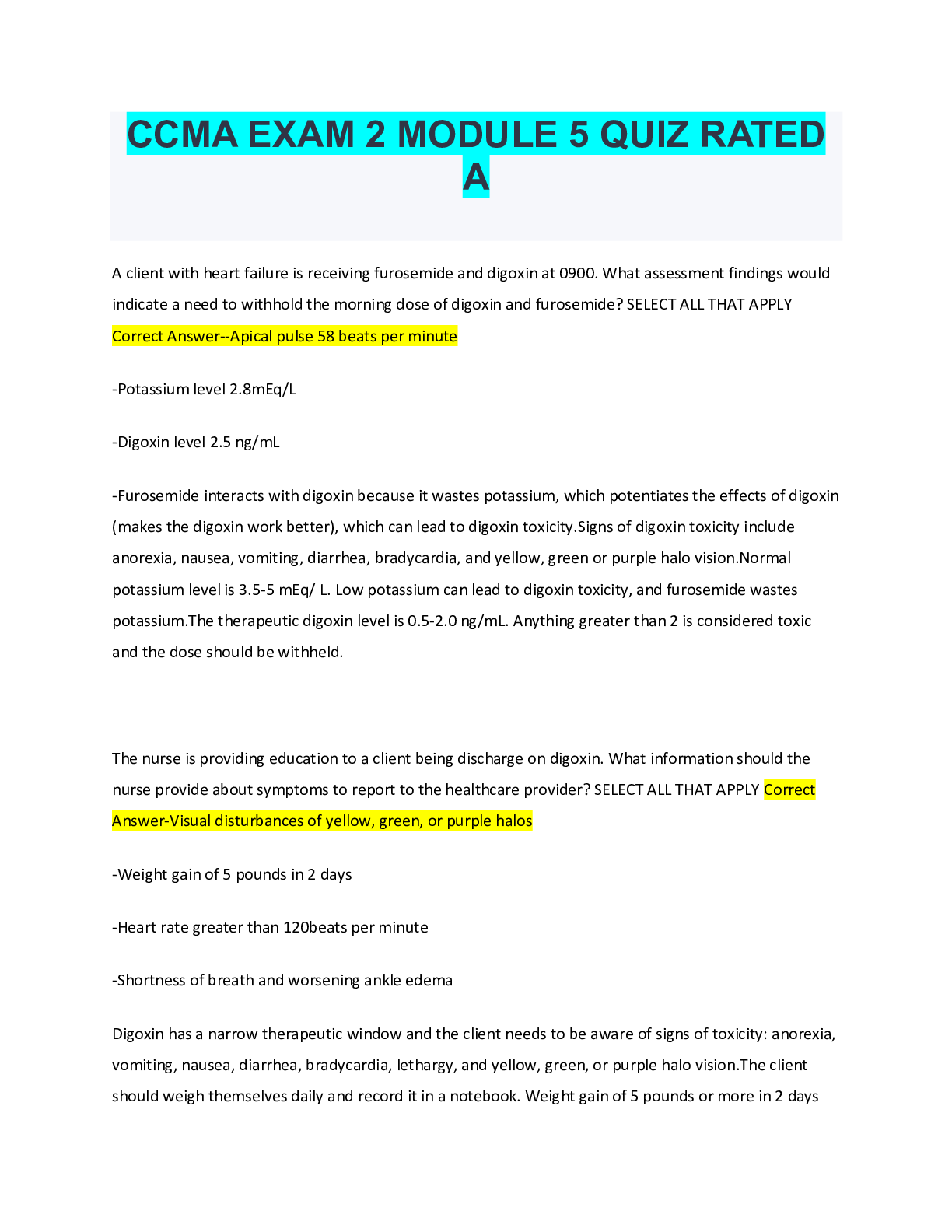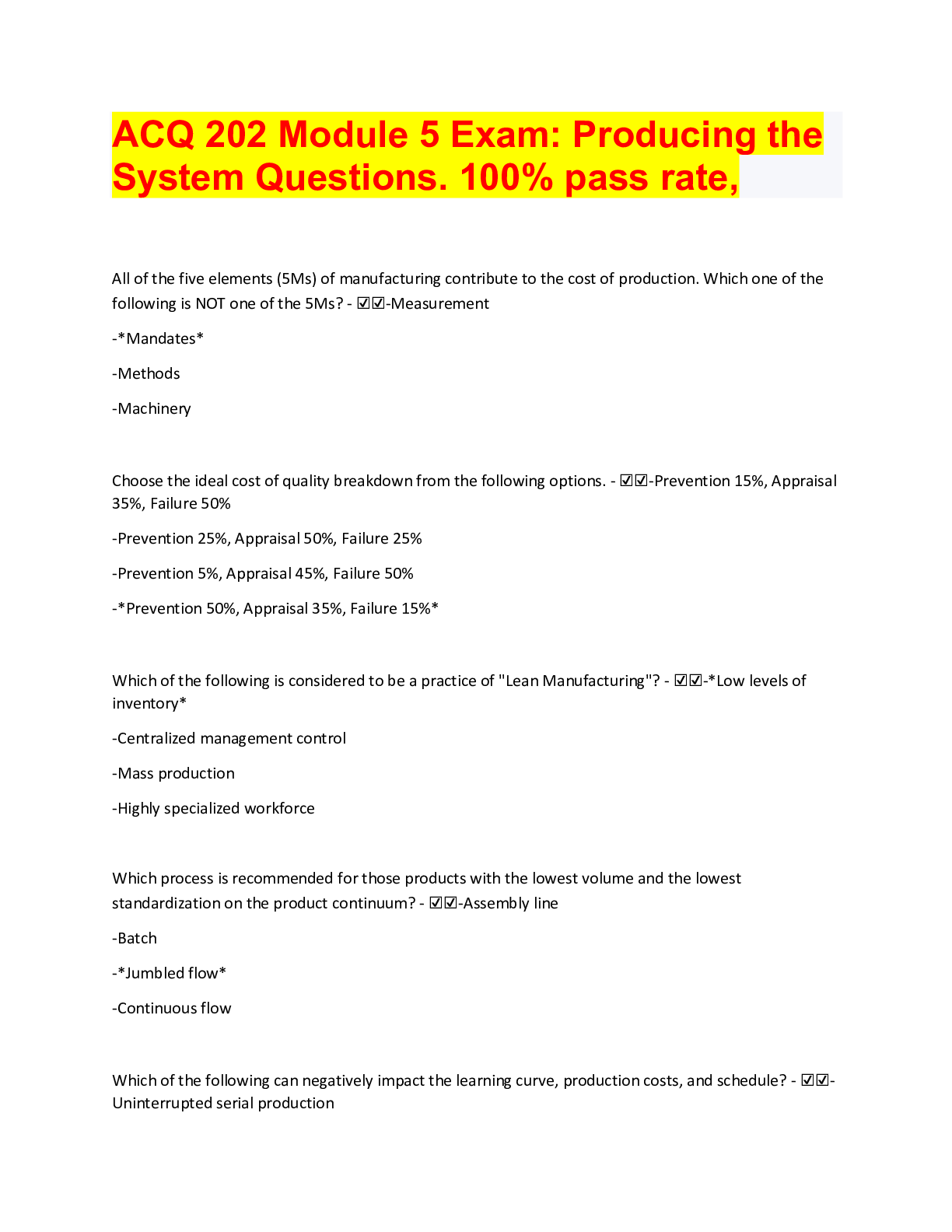*NURSING > QUESTIONS & ANSWERS > CCMA EXAM 2 MODULE 5 QUIZ RATED A+. 2022/2023 update. (All)
CCMA EXAM 2 MODULE 5 QUIZ RATED A+. 2022/2023 update.
Document Content and Description Below
CCMA EXAM 2 MODULE 5 QUIZ RATED A A client with heart failure is receiving furosemide and digoxin at 0900. What assessment findings would indicate a need to withhold the morning dose of digoxin and... furosemide? SELECT ALL THAT APPLY Correct Answer--Apical pulse 58 beats per minute -Potassium level 2.8mEq/L -Digoxin level 2.5 ng/mL -Furosemide interacts with digoxin because it wastes potassium, which potentiates the effects of digoxin (makes the digoxin work better), which can lead to digoxin toxicity.Signs of digoxin toxicity include anorexia, nausea, vomiting, diarrhea, bradycardia, and yellow, green or purple halo vision.Normal potassium level is 3.5-5 mEq/ L. Low potassium can lead to digoxin toxicity, and furosemide wastes potassium.The therapeutic digoxin level is 0.5-2.0 ng/mL. Anything greater than 2 is considered toxic and the dose should be withheld. The nurse is providing education to a client being discharge on digoxin. What information should the nurse provide about symptoms to report to the healthcare provider? SELECT ALL THAT APPLY Correct Answer-Visual disturbances of yellow, green, or purple halos -Weight gain of 5 pounds in 2 days -Heart rate greater than 120beats per minute -Shortness of breath and worsening ankle edema Digoxin has a narrow therapeutic window and the client needs to be aware of signs of toxicity: anorexia, vomiting, nausea, diarrhea, bradycardia, lethargy, and yellow, green, or purple halo vision.The client should weigh themselves daily and record it in a notebook. Weight gain of 5 pounds or more in 2 daysshould be reported the the healthcare provider.While bradycardia is a common sign of toxicity with digoxin, tachycardia can also be a sign of digoxin toxicity. It can also be a sign that the dose is not controlling the symptoms of heart failure. Tachycardia should be reported to the healthcare provider so the etiology of the increased heart rate can be identified.If you watched the video on heart failure, you are aware that fluid retention is a big part of the disease process. If the client is experiencing shortness of breath and ankle edema, these are signs of worsening heart failure and should be reported.While the blood pressure is a little lower than normal, a failing heart will struggle meeting the demands of the body. A blood pressure of 100/50 is life sustaining and may be the best that a patient with heart failure can produce. A nurse is providing education to a client with heart failure. What non-pharmacological interventions should the nurse include in the information about disease management? SELECT ALL THAT APPLY Correct Answer--Exercise daily, as possible. -Stop smoking -Decrease saturated fat intake -Limit alcohol intake Non-pharmacological treatment for heart failure includes: Decreasing sodium to less than 2 grams per day, mild exercise as the client is able, decreasing saturated fat intake, limit alcohol intake. The nurse is reviewing the client's medical record before providing discharge instructions. Find the information below: Admitting DiagnosisDehydration Past Medical Diagnosis:Heart Failure, chronic stable angina, hypertensionDischarge Medication Orders:digoxin 0.125 mg PO dailyfurosemide 40 mg PO BID at 0900 and 1700 metoprolol 25 mg PO daily isosorbide dinitrate 20 mg PO daily nitroglycerin 0.4 mg SL PRN chest pain. What information should the nurse include in the discharge instructions? SELECT ALL THAT APPLY Correct Answer--Smoking cessation will help with disease management. -Take your pulse every day before taking your morning medications and notify your healthcare provider if heart rate is less than 60 beats per minute -Increase foods high in potassium because furosemide increases potassium loss -Rise slowly, in stages, because metoprolol and isosorbide dinitrate can cause low blood pressure upon standing. -Store the nitroglycerin in original container, keeping it away from heat and moisture. Report yellow, green, or purple halos around lights as this could be a sign of digoxin toxicity -Based on the discharge medications, the nurse must educate the client on potential adverse effects and when/what to report to the healthcare provider.With angina and heart failure, smoking cessation is part of disease management. Taking the pulse daily and reporting heart rate less than 60 is important since it can be a sign of digoxin toxicity, and metoprolol can also lower the heart rate. Since the cllient will be on furosemide and digoxin, the client should increase foods high in potassium to help prevent hypokalemia and the potential for digoxin toxicity related to hypokalemia. Since the client is on a beta blocker and a nitrate, the client is at risk for orthostatic hypotension and should be taught to rise slowly, in stages. Storage of nitroglycerine includes keeping it in the original container, or a specially made dark, moisture resistant container, keeping the medication at room temperature and away from moisture. SL nitroglycerin should be taken 5 minutes apart, with a maximum of 3 doses. The client should call 9-1-1 after the second dose if chest pain persists (also book has another location that says after first dose).The client should weigh themselves daily and report a weight gain of 5 pounds or more in 2 days.The client needs to be taught about signs of digoxin toxicity and to report them to their HCP.A client will be starting on a transdermal patch for treatment of chronic stable angina. What education should the nurse provide the client? SELECT ALL THAT APPLY Correct Answer-Remove the old patch before applying the new patch -Cleanse the previous patch site to prevent irritation -Do not apply the patch to the same location every day. -Apply the patch at the same time each day -Avoid saunas and hot tubs because these increase vasodilation -When applying a transdermal nitroglycerin patch, the client needs to : rotate sites, avoid the areas distal of the elbows and knees, clean the previous site area, apply the patch at the same time every day. The client should avoid saunas and hot tubs as they can increase vasodilation, which can lead to fainting and orthostatic hypotension. A client diagnosed with heart failure is being taught about drug interactions that can occur with digoxin. Match the medication or herbal supplement with the resulting interaction. Correct Answer-Potassium wasting diuretics: Causes low potassium that potentiates the effects of digoxin, leading to digoxin toxicity Ginseng: Increases digoxin levels, leading to digoxin toxicity Saint John's Wort: Decreases digoxin levels, leading to uncontrolled disease process Beta blockers: Enhances bradycardic effect of digoxin Amiodorone: Decreases excretion of digoxin, leading to a 50% increase in digoxin levelsA client with a history of angina, type 2 diabetes mellitus, and heart failure is to have surgery. Which medication should be administered on the morning of surgery? Correct Answer-metoprolol Beta blockers are administered on the morning of surgery because of their cardioprotective effects. The patient takes the beta blocker with a small sip of water. ACE inhibitors, angiotensin II receptor blockers and metformin should all be held on the morning of surgery. After providing education about the newly prescribed metoprolol for a client with angina, what statement made by the client would indicate a need for additional education? Correct Answer-"I should take this medication to stop an attack of angina." Beta-blockers decrease the workload of the heart, preventing angina and myocardial infarctions. They are not indicated to treat an acute angina attack.XL on any medication designates this as a sustained release medication and all sustained release medications should not be crushed or cut because this can cause a bolus of the medication, causing overdose symptoms.Orthostatic hypotension is common with beta-blockers, so the client will need to be careful with position changes.When on a beta-blocker, the client should count their pulse daily and report heart rate less than 60. What medication can cause a fatal drop in blood pressure if taken with nitroglycerin? Correct A [Show More]
Last updated: 1 year ago
Preview 1 out of 10 pages
Instant download

Buy this document to get the full access instantly
Instant Download Access after purchase
Add to cartInstant download
Also available in bundle (1)

CCMA Bundle, top Exam Papers
Down load this bundle for easy revisions. ALL LATEST VERSIONS, OVER 2000 EXAM QUESTIONS WITH ACCURATE ANSWERS, VERIFIED.
By bundleHub Solution guider 1 year ago
$32
57
Reviews( 0 )
Document information
Connected school, study & course
About the document
Uploaded On
Sep 08, 2022
Number of pages
10
Written in
Additional information
This document has been written for:
Uploaded
Sep 08, 2022
Downloads
0
Views
184












.png)


.png)
.png)
.png)
.png)

